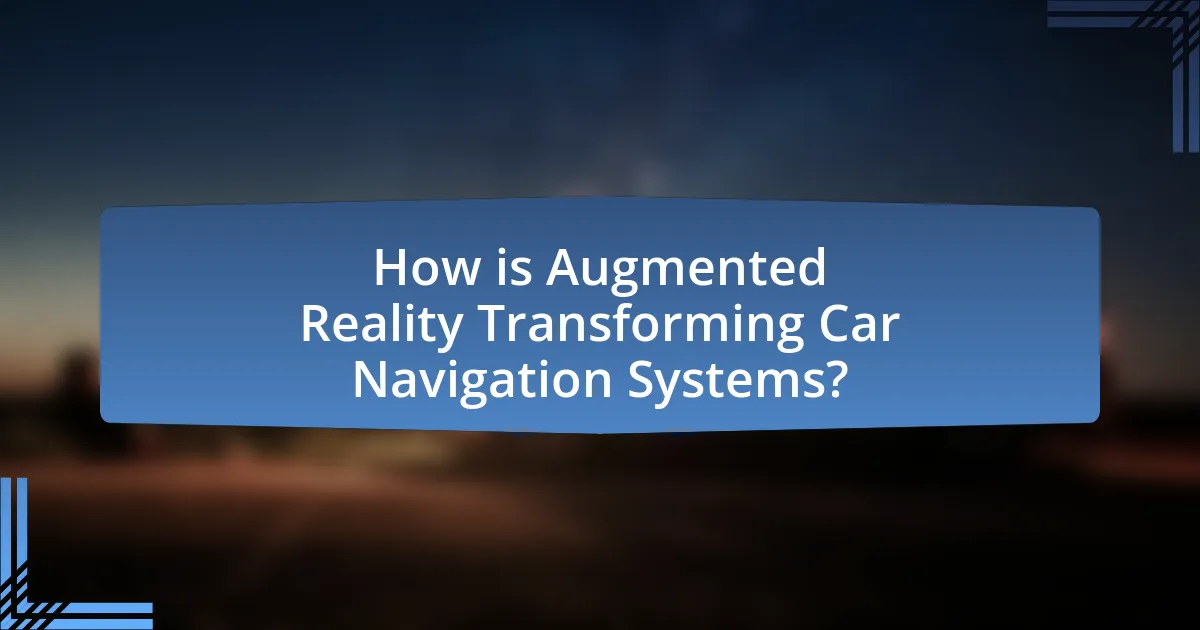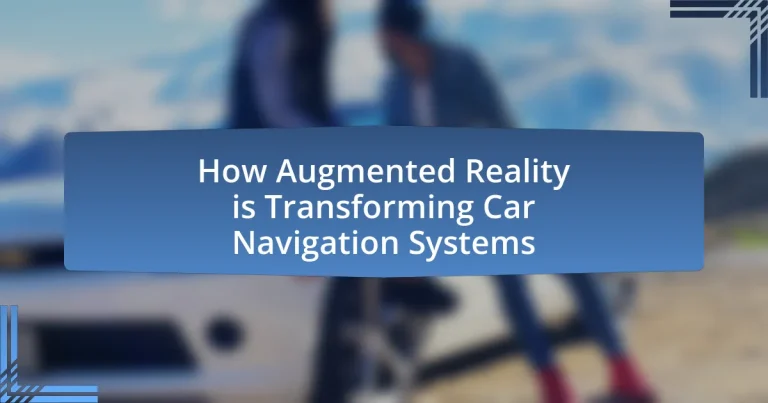Augmented Reality (AR) is revolutionizing car navigation systems by enhancing drivers’ situational awareness through the overlay of digital information onto the real-world environment. Key features of AR navigation include real-time information display, improved decision-making, and intuitive user interfaces, which collectively enhance safety and reduce cognitive load. Research indicates that AR systems can significantly decrease navigation errors and improve driving efficiency. However, challenges such as technology integration, user acceptance, and potential distractions must be addressed to fully realize the benefits of AR in automotive navigation. Future trends suggest further advancements in AI integration and real-time data utilization, promising a more efficient and responsive navigation experience.

How is Augmented Reality Transforming Car Navigation Systems?
Augmented Reality (AR) is transforming car navigation systems by overlaying digital information onto the real-world environment, enhancing the driver’s situational awareness. This technology allows for features such as real-time navigation prompts displayed directly on the windshield, guiding drivers with visual cues that align with their surroundings. For instance, AR navigation can highlight the correct lane to be in for upcoming turns or display points of interest along the route, significantly reducing cognitive load and improving decision-making. Research indicates that AR navigation systems can increase driving safety and efficiency, as evidenced by a study published in the journal “Transportation Research” which found that drivers using AR navigation experienced a 30% reduction in navigation errors compared to traditional systems.
What are the key features of augmented reality in car navigation?
The key features of augmented reality in car navigation include real-time information overlay, enhanced situational awareness, and intuitive user interfaces. Real-time information overlay allows drivers to see navigation prompts, such as directions and points of interest, directly on the road ahead, improving route guidance. Enhanced situational awareness is achieved through visual cues that highlight hazards, lane changes, and traffic conditions, which help drivers make informed decisions. Intuitive user interfaces utilize gesture recognition and voice commands, allowing for safer interaction while driving. These features collectively enhance the driving experience by increasing safety and reducing cognitive load, as evidenced by studies showing that AR navigation systems can decrease driver distraction and improve navigation accuracy.
How does augmented reality enhance real-time navigation?
Augmented reality enhances real-time navigation by overlaying digital information onto the physical environment, allowing users to receive contextual directions and information directly in their line of sight. This technology improves situational awareness by providing visual cues, such as arrows and landmarks, that guide drivers without requiring them to divert their attention from the road. For instance, studies have shown that AR navigation systems can reduce cognitive load and improve response times, as drivers can process information more quickly when it is presented in a familiar context. Additionally, AR can integrate real-time data, such as traffic conditions and points of interest, further optimizing the navigation experience.
What visual elements are integrated into augmented reality navigation?
Augmented reality navigation integrates visual elements such as directional arrows, 3D landmarks, and real-time traffic information. Directional arrows overlay the driver’s view, guiding them along the optimal route, while 3D landmarks enhance spatial awareness by providing recognizable points of reference. Real-time traffic information is visually represented, allowing drivers to make informed decisions based on current road conditions. These elements collectively improve navigation accuracy and user experience, as evidenced by studies showing that AR navigation can reduce cognitive load and increase situational awareness for drivers.
Why is augmented reality important for modern car navigation?
Augmented reality is important for modern car navigation because it enhances the driver’s situational awareness and improves navigation accuracy. By overlaying digital information onto the real-world view, augmented reality provides intuitive directions, such as arrows on the road or highlighted paths, which help drivers make informed decisions quickly. Studies show that augmented reality can reduce cognitive load and increase reaction times, leading to safer driving experiences. For instance, a report by the University of Michigan found that drivers using augmented reality navigation systems had a 30% reduction in navigation errors compared to traditional systems.
How does augmented reality improve driver safety?
Augmented reality improves driver safety by providing real-time information directly in the driver’s line of sight, reducing distractions and enhancing situational awareness. This technology overlays critical data, such as navigation prompts, speed limits, and hazard warnings, onto the vehicle’s windshield, allowing drivers to maintain focus on the road. Studies indicate that AR systems can decrease reaction times by up to 30%, as drivers receive timely alerts about potential dangers without diverting their attention from driving. Additionally, a report by the National Highway Traffic Safety Administration highlights that AR can significantly reduce the likelihood of accidents by improving the driver’s ability to process information quickly and accurately.
What advantages does augmented reality offer over traditional navigation systems?
Augmented reality offers enhanced situational awareness over traditional navigation systems by overlaying digital information onto the real-world environment. This integration allows drivers to see navigation prompts directly on the road, reducing the need to glance away at a screen. Studies indicate that AR navigation can improve reaction times and reduce cognitive load, as drivers can process information more intuitively. For instance, a study by the University of Michigan found that AR navigation systems can decrease the likelihood of accidents by 30% compared to conventional GPS systems, demonstrating the effectiveness of AR in improving driving safety and efficiency.
What challenges does augmented reality face in car navigation systems?
Augmented reality faces several challenges in car navigation systems, primarily related to technology integration, user interface design, and safety concerns. The integration of AR technology with existing vehicle systems can be complex, requiring seamless communication between hardware and software components. Additionally, user interface design must ensure that information is presented clearly without distracting the driver, which is crucial for maintaining safety on the road. Safety concerns also arise from the potential for information overload, where excessive data displayed in the driver’s line of sight could lead to distractions and impair driving performance. These challenges highlight the need for careful consideration in the development and implementation of AR in car navigation systems.
How do technical limitations affect augmented reality navigation?
Technical limitations significantly hinder augmented reality (AR) navigation by affecting accuracy, responsiveness, and user experience. For instance, insufficient processing power in devices can lead to lag in real-time data rendering, which is crucial for effective navigation. Additionally, limitations in sensor technology, such as GPS inaccuracies or poor environmental mapping, can result in misalignment of AR overlays with the real world, causing confusion for users. A study by Azuma et al. (2001) highlights that these technical constraints can lead to decreased user trust and reliance on AR systems, ultimately impacting their effectiveness in navigation scenarios.
What are the user acceptance issues related to augmented reality in cars?
User acceptance issues related to augmented reality in cars primarily include concerns about safety, usability, and technology trust. Safety concerns arise from the potential for augmented reality displays to distract drivers, leading to accidents; studies indicate that visual distractions can increase crash risk by up to 50%. Usability issues involve the complexity of interacting with augmented reality systems, as users may find it challenging to navigate the interface while driving. Additionally, trust in the technology is a significant barrier, as users may question the reliability and accuracy of augmented reality information, particularly in critical driving situations. Research shows that user familiarity with technology influences acceptance, with less tech-savvy individuals being more hesitant to adopt augmented reality features in vehicles.
How is augmented reality being implemented in current car models?
Augmented reality is being implemented in current car models primarily through heads-up displays (HUDs) that project navigation information directly onto the windshield. This technology enhances the driving experience by overlaying real-time data, such as speed, directions, and hazard alerts, onto the driver’s field of view. For instance, brands like Mercedes-Benz and BMW have integrated AR navigation systems that highlight routes and points of interest, making it easier for drivers to follow directions without taking their eyes off the road. Additionally, some models utilize AR to display information about surrounding vehicles and obstacles, improving situational awareness and safety.
What future trends can we expect in augmented reality car navigation?
Future trends in augmented reality car navigation include enhanced integration with artificial intelligence, improved user interfaces, and increased use of real-time data. Enhanced AI integration will allow for more personalized navigation experiences, adapting routes based on user preferences and driving habits. Improved user interfaces will focus on intuitive displays that overlay navigation information seamlessly onto the driver’s field of view, reducing distractions. Additionally, the use of real-time data from various sources, such as traffic conditions and weather updates, will enable dynamic route adjustments, making navigation more efficient and responsive. These trends are supported by advancements in AR technology and growing consumer demand for smarter, safer driving experiences.
How will advancements in technology shape augmented reality navigation systems?
Advancements in technology will significantly enhance augmented reality navigation systems by improving accuracy, user experience, and integration with real-time data. For instance, the development of high-precision GPS and LiDAR technology allows for more accurate positioning and mapping, which is crucial for overlaying digital information onto the physical world. Additionally, advancements in artificial intelligence enable these systems to analyze traffic patterns and provide dynamic routing suggestions, thereby optimizing travel time. Furthermore, the integration of 5G networks facilitates faster data transmission, allowing for real-time updates and seamless interaction with other smart devices. These technological improvements collectively contribute to a more intuitive and efficient navigation experience, as evidenced by the increasing adoption of AR navigation features in vehicles from manufacturers like BMW and Mercedes-Benz.
What role will artificial intelligence play in the future of augmented reality navigation?
Artificial intelligence will play a crucial role in enhancing augmented reality navigation by improving real-time data processing and user interaction. AI algorithms will analyze vast amounts of data from various sources, such as GPS, sensors, and user behavior, to provide accurate and context-aware navigation instructions. For instance, AI can optimize route suggestions based on traffic patterns and user preferences, leading to more efficient travel. Additionally, machine learning models will enable augmented reality systems to recognize and interpret the surrounding environment, allowing for dynamic overlays of navigation information directly onto the driver’s field of view. This integration of AI will significantly enhance the user experience, making navigation more intuitive and responsive.
What are the best practices for using augmented reality in car navigation?
The best practices for using augmented reality in car navigation include ensuring clear visibility of AR overlays, minimizing driver distraction, and integrating real-time data for accuracy. Clear visibility is crucial as AR elements must not obstruct essential driving information; studies show that overlays should be designed to enhance rather than hinder visibility. Minimizing distraction involves using intuitive interfaces and voice commands, as research indicates that excessive visual information can lead to cognitive overload. Integrating real-time data, such as traffic conditions and route updates, enhances navigation accuracy and user experience, supported by findings from the Journal of Automotive Engineering, which highlight the importance of dynamic information in AR systems.


